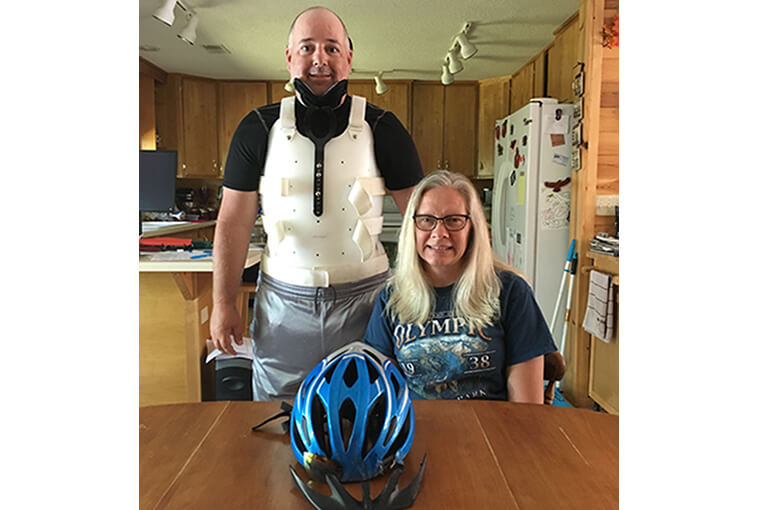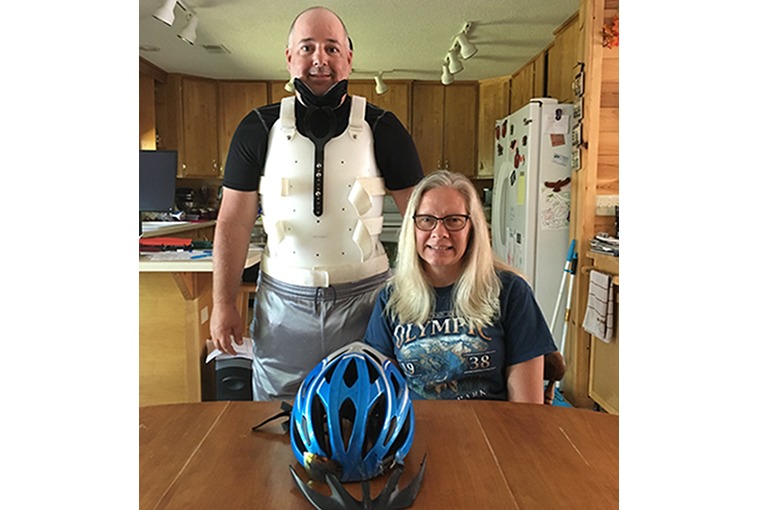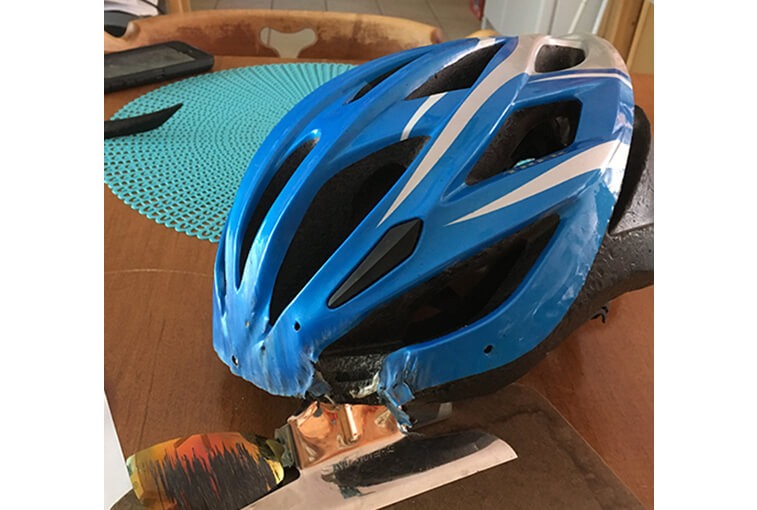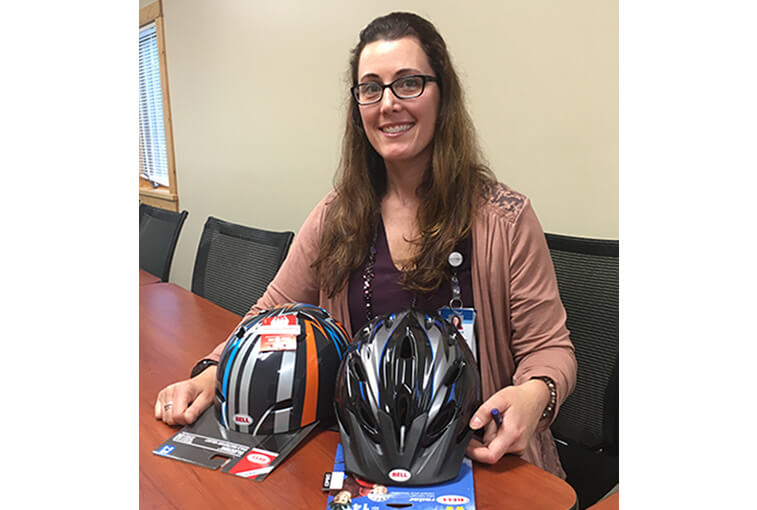Matt Puro enjoys the freedom that can be found on a bicycle. For the past 13 years, Puro’s daily exercise schedule includes an 18- to 20-mile ride along the Paul Bunyan Trail on the east side of Lake Bemidji in Northern Minnesota.
On June 4, 2018, however, that bicycle ride was cut short by an accident and Puro experienced firsthand the workings of the trauma teams at the Sanford Medical Center in Bemidji and at Sanford Health Fargo, North Dakota.
“I purposely stay on the trail system the entire time while on my bike ride to avoid traffic,” said Puro, who is a timber buyer. “I live 200 yards from the trail and each day I would get home from work, grab my bike, head for the trail and do the exercise.”
On June 4 Puro was, as usual, on the trail but this time he was riding his wife’s bicycle.
“My bike has had chronic flat tires this spring and on this particular day I took (wife) Bonnie’s bike instead of mine,” said Puro, who likes to ride between 15 and 20 miles per hour. “The main difference between our bikes is that our brake sensitivity is set very differently. I always set my brakes very loose.”
“And on my bike, you barely have to touch the brakes to get the bike to stop,” Bonnie said.
Puro’s ride that day was normal until he neared the intersection with Loon Lane just north of the Lake Bemidji river outlet. He could see a vehicle on Loon Lane and, knowing that it is the biker’s responsibility to yield to vehicles, Puro began his coasting routine, which begins with gentle pressure on the brakes.
Instead of gradually reducing speed, however, the bicycle abruptly stopped and Puro flew over the handle bars.
The front left side of his helmet took the brunt of the impact with the asphalt trail and the left lens of his sunglasses sustained deep scrapes.
“He came into the emergency room with pretty significant trauma head to toe,” said LynMaree Harris, the trauma program manager and coordinator for Sanford Health in Northern Minnesota. Among those on the trauma team are intensive care unit nurses, emergency room physicians, lab and radiology technicians, emergency room technicians and personnel from respiratory therapy.
“Everybody has their roles and responsibilities,” Harris said. “We get things done quickly and efficiently and then we determine the next steps.”
Possible brain damage
Diagnosis by the trauma team, combined with imaging, revealed that Puro’s bicycling injuries included a closed head injury with concussion, also known as a mild traumatic brain injury (TBI), complex facial fractures, bleeding in the left eye, cervical spinal cord compression, a fracture of the T7 vertebrae and a fracture of the left shoulder.
“He also had numbness of the hand, which was diagnosed as being caused by the central cord syndrome (spinal cord compression), and that is very common with hyperextension of the neck,” Harris said.
“I spent about three or four hours at the emergency room in Bemidji and they decided to fly me to Fargo,” Puro said. “At Fargo they were most concerned about possible brain damage because they saw bleeding in the eye and injury to my head.”
“Matt met our criteria … to activate the trauma team and to have the trauma team assess the severity of those injuries,” Harris said. “Our trauma team determines the severity of a patient’s injuries and determines if the patient is better suited at a higher level trauma center. In this case, because of the fracture of the T7 vertebrae and the head injury, the patient needed the services of a neurosurgeon and, because our neurosurgeon is in Fargo, we notified AirMed right away regarding the patient’s transfer.”
Treated by entire team
“The people at the emergency room in Bemidji covered everything,” Puro said, “and I appreciate their attention to detail. They also determined that the best place for me was Fargo and they arranged everything for the transfer.
“And the people in Fargo were fabulous,” he continued. “I was dealing with five or six doctors who were part of my care team there and I couldn’t list all of the people who were working on me. There were surgeons, internal doctors, urology people, the nursing staff and others. Every day I felt thankful for the people in Fargo and in Bemidji. I never had any wants and I never needed to ask for anything.”
Puro spent two weeks in Fargo and returns when needed for follow-up care. Although his bicycling injuries were severe, he knows the situation could have been much worse.
“I consider myself in the ‘lucky to be moving department,’” he said. “Nobody can tell how much worse my brain injury could have been if I had not been wearing my helmet.”
‘Brain Bucket’ campaign
In an effort to educate people about the benefits of wearing helmets, the Bemidji trauma program has developed the community “Brain Bucket” campaign. Started in 2015, the effort is designed to promote safety and awareness of bicycling injuries to the head, and ways to prevent them.
As part of the Brain Bucket campaign, Harris has purchased helmets for bicyclists, skateboarders and other summer sport enthusiasts. One of the main target groups is the 15- to 25-year-olds.
“Our primary focus is adolescents and youth because that group tends to have the highest incidents of not wearing a helmet. They also are at the highest risk for TBI because their brains are still developing,” Harris said.
Harris is spreading the word about the importance of wearing a helmet at area school health fairs, community and school appreciation events, on Facebook and also through various media outlets.
“For me, a helmet is a piece of equipment that goes with my bike, just like the seatbelt in my car,” Harris said. “Matt is a great example of a good outcome by wearing a helmet. He had a bad overall outcome, but it could have been a lot worse without the helmet.”
“Something as innocent as a bike ride can go wrong in a second and even before you realize what’s happening,” Puro said. “When I needed it, I’m was sure thankful that I had my helmet on. I have no repercussions about getting back on my bike and I’ll do that as soon as I have clearance (from his doctors). But you can bet that I’ll be wearing my helmet.”
…
Posted In Allied Health, Brain & Spine, Emergency Medicine, Imaging, Neurology, Orthopedics, Rehabilitation & Therapy



